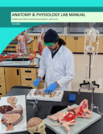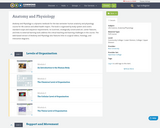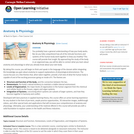
Basic anatomy of the heart.
- Subject:
- Anatomy/Physiology
- Life Science
- Material Type:
- Diagram/Illustration
- Author:
- Dr. Hamid Nawaz
- Date Added:
- 04/26/2022

Basic anatomy of the heart.

basic overview of the respiratory system anatomy.

In this episode of Crash Course, Hank introduces you to the complex history and terminology of Anatomy & Physiology.
Chapters:
Introduction
History of Anatomy
Physiology: How Parts Function
Complementarity of Structure & Function
Hierarchy of Organization
Directional Terms
Review
Credits

This anatomy & physiology lab manual is meant for a two semester course, covering every system of the human body. It contains lecture notes, labs, videos, and the online version has added activities and games.

This is the open educational resource for BIO2311: Anatomy & Physiology I. This site provides all you will need for the course including a syllabus, link to the textbook, lecture notes, assignments, and all other related resources.

Welcome to the Anatomy and Physiology section of WikiVet. Anatomy is the study of form and structure of organisms, whilst physiology is the study of the function of an organism and the processes, physical, chemical and biological, occuring within it. Here we cover all the anatomical and physiological points that make up our domestic species and exotic species.

The structure of the human body is usually considered in courses in gross anatomy. These courses typically consist of lectures by the faculty, readings in assigned textbooks and the study of photographs and illustrations in human anatomy atlases. However, as student’s progress through the curriculum and move into the more clinical or practice oriented phases, many discover that the anatomical knowledge they actually need is somewhat different from the kind they possess. What many encounter is difficulty in applying their knowledge to a clinical setting.
Applied Human Anatomy was created to better integrate material that is more often than not treated separately in contemporary health care curricula. It is hoped that through this integration students will develop a deeper and more lasting knowledge and understanding of human anatomy as they are likely to need it in the evaluation and management of patients.
A print version is available for purchase on Amazon.

OER Review of Anatomy & Physiology
https://www.google.com/url?q=https://drive.google.com/open?id%3D1zlu-3oTg1i5_iAbJGoRHAMLmVB3hLD7fR7m0kWDAjmM&sa=D&ust=1592330036923000&usg=AFQjCNEESIB7mnt879ZcBCO0EurW1CBXeg

basic anatomy of the pelvic cavity

Anatomy and Physiology is a dynamic textbook for the two-semester human anatomy and physiology course for life science and allied health majors. The book is organized by body system and covers standard scope and sequence requirements. Its lucid text, strategically constructed art, career features, and links to external learning tools address the critical teaching and learning challenges in the course. The web-based version of Anatomy and Physiology also features links to surgical videos, histology, and interactive diagrams.

Pioneers in Human Anatomy provides an opportunity for those who may be interested in those pioneers in anatomy or who may have learned (or forgotten) some eponymonic descriptions in the past, to test their knowledge (or memory) of these historical designations or to link particular individuals to anatomical structures and features previously unknown. While students and teachers of anatomy may might have a professional interest in knowing who, in the history of anatomy, has been associated with a particular structure, others including medical historians, biographers and medical artist might also find this information of interest. This collection of free-answer quiz questions is divided into three sections. In the first section a brief description of an anatomical structure, feature, tissue, cell or pathway is presented followed by a blank line in which the reader may insert the name(s) of the individual(s) commonly associated with that structure, feature, tissue or pathway. The descriptions and individuals included here are limited to those associated with the four traditional sub-disciplines of anatomy: gross anatomy, neuroanatomy, microscopic anatomy and developmental anatomy. Within these major anatomical subdisciplines, the descriptions are further categorized to better organize the material. Some eponyms have come into the literature because that individual was the first to report on a particular topic (aqueduct of Sylvius) or may have provided the most definitive description of the topic (Parkinson disease). Others recognize the committed effort or discovery of a single individual (islets of Langerhan) while others signify the combined or collaborative efforts of two or more dedicated persons (Marchiafava-Bignami disease). Some refer to normal structures (Hunter’s canal) or functions (Starling’s law), while many others relate to abnormal observations (Babinski sign). Countless numbers are associated with diseases (Tay-Sachs disease) or injuries (Colle’s fracture), procedures for evaluating functions (McMurray’s test) or techniques for treating specific disease or injuries (Epply maneuver). Eponymonic designations are used to identify tools and surgical instruments invented for particular purposes (Kerrison Rongeur) and surgical procedures (Whipple procedure). Some eponyms are associated with other, frequently more descriptive terms (Poupart’s ligament / inguinal ligament) while others indicate structures, processes or procedures for which no other name exists (McBurney’s point). As can be appreciated from this brief synopsis, eponyms are well ingrained into almost all facets of medicine.

These projects are intended to enhance the anatomy and physiology course content. I've designed these so that the group project is coimpatible with a traditional A&P 1 course, and the individual project is compatible with a traditional A&P 2 course. However, both of these projects can work with either course, albeit with minor modifications.

Syllabus for the second half of a comprehensive study of the structure and function of the human body. This course uses an open textbook, Anatomy & Physiology, from OpenStax.

OpenStax
Short Description:
An adapted and revised edition of the OpenStax Anatomy & Physiology (https://openstax.org/details/books/anatomy-and-physiology) with revised content and artwork, Open Oregon State, Oregon State University. Data Dashboard
Long Description:
An adapted and revised edition of the OpenStax Anatomy & Physiology (https://openstax.org/details/books/anatomy-and-physiology) with revised content and artwork, Open Oregon State, Oregon State University.
Word Count: 551108
(Note: This resource's metadata has been created automatically by reformatting and/or combining the information that the author initially provided as part of a bulk import process.)

Basic anatomy of the female reproductive system.

You probably have a general understanding of how your body works. But do you fully comprehend how all of the intricate functions and systems of the human body work together to keep you healthy? This course will provide that insight. By approaching the study of the body in an organized way, you will be able to connect what you learn about anatomy and physiology to what you already know about your own body.
By taking this course, you will begin to think and speak in the language of the domain while integrating the knowledge you gain about anatomy to support explanations of physiological phenomenon. The course focuses on a few themes that, when taken together, provide a full view of what the human body is capable of and of the exciting processes going on inside of it.
To access this course, click "Enter Open & Free Course," then "Enter course" under "Enter without an account."

In groups, students will design a presentation that will trace the development of an organ system through the major phyla of the animal kingdom looking for the relationships between structure and function by documenting adaptations.

Lab homework meant to accompany the Openstax Anatomy & Physiology textbook

Basic anatomy of the face muscles. frontalis, procereus, nasalis, zygomaticus minor, mentalis, depressor labii inferioris, depressor angularis oris, levator...

Short video on urinary system anatomy for anatomy and physiology.